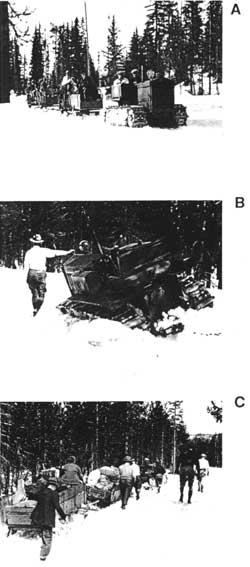The Battle Against Bark Beetles in Crater Lake National Park: 1925-34
Events From 1929 and 1930
For the beetle battlers, 1929 was a very bad year. Thousands of lodgepole pine became infested in 1928 from what Patterson described as continued infiltration of beetles drifting from north of the lake, even though very few live trees were supposedly left in that area. Also in some areas, two broods developed thereby producing two sets of infested trees instead of the usual one (see footnote 15). Altogether, 23,239 trees were treated across 9,000 acres at a cost of $17,038.91. The Crater National Forest treated 8,199 trees at a cost of $2,000 (see footnote 15). The fall 1928 survey, according to Chief Ranger William C. Godfrey, actually estimated that only 4,500 trees would have to be treated in 1929. [16] This was a 75-percent under estimate when tallies were made at the end of the 1929 control work. Godfrey mentioned that the crews again faced snow depths of 6 feet or more when they tried to set up camps in late April. Again they resorted to tractors to drag camp equipment and crews to Anna Creek. The most disturbing part of Godfrey’s report was that they had to leave 4,070 trees untreated (see footnote 16).
Brown was again in charge of Forest Service control work in 1929 and his report makes some interesting statements not included in other reports. [17] Brown thought the smoke from slash fires along the road attracted more beetles to the roadside area in 1929, and he mentioned that 1929 was unseasonably dry and favorable to the beetles. He was in charge of control operations in the park (upper Sand Creek) under J.E. Patterson. This is the first indication that Forest Service crews worked within park boundaries. Brown also made the first mention of possible beneficial effects of opening a stand during logging as follows (see footnote 17):
At Mr. Jaenicke’s suggestion an examination was made of sale cuttings in the lodgepole pine in this area. An examination of 70 acres cut over by the Pelican Bay Lbr. Co. for ties in 1925 disclosed two old beetle infested trees and two infested trees whereas adjoining ground not cut over showed groups of from 4-20 trees which had been or were infested. It may be that opening the stand increases beetle resistance of the remaining trees. During 1929 cutting was made by the Algoma Lbr. Co. in lodgepole pine near Boundary Butte. This would offer an excellent chance for experimental study of beetle activity in cut over areas should the District Office or the Bureau of Entomology care to undertake such work.
Unfortunately no followup studies were done.
Brown also had an interesting antidote for bears in camp:
Bear raided the cookhouse in 1929 due to their having acquired the habit of visiting the road camp. [The Sand Creek entrance highway was under construction.] If they are fed regularly they will come at that time and should be driven away at other times (see footnote 17).


